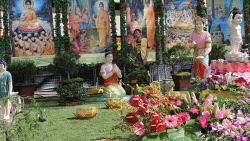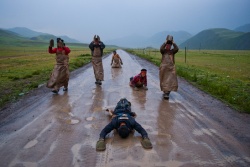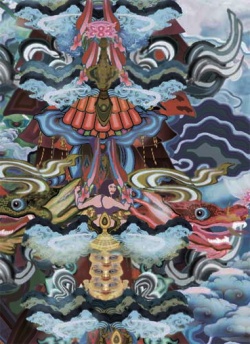Introduction to the Jonang tradition
While few outside academic circles have ever heard of the Jonang, it is not a new tradition. The Jonang trace their lineage back to India and the great Nalanda University. However, it did not become known by the name Jonang until its founder Kunpang Thukje Tsondru, settled in the Jomonang valley of Tibet during the 13th century.
One of the reasons that so few people are currently aware of the Jonang is due to the fact that they did not flee Tibet in 1959. So when the Tibetan Administration in Exile began registering traditions, the Jonang were absent. Therefore, very few foreigners were ever introduced to their authentic teachings.
It was not until 1990 that the first Jonang monks began to emerge from Tibet. Since then they have been requesting the Tibetan Administration to recognise their tradition as worthy of equal respect as the Nyingma, Kagyu, Sakya, Gelug and Bön traditions. While great advances have been made in respect to this, unfortunately this work is still not complete.
Why is the Jonang Tradition important?
Firstly, the Zhentong Madyamika philosophy is recognised as the highest view by many of the most realised Tibetan masters. The Jonang is the only one of the five major Tibetan Buddhist schools that emphasises this unique doctrine and upholds its lineage.
Secondly, the Kalachakra Tantra is the most comprehensive and effective system within Tibetan Buddhism. The Jonang is the only tradition that holds the entire Kalachakra system, including the unique completion practice known as the “Six Vajra Yogas”.
It is because the Jonang are the core holders of these two important lineages that it is crucial that the Jonang Dharma flourish. Failure to do so will result in the loss of these irreplaceable spiritual systems.
Lineages of the Jonang Tradition
All Buddhist teachings rely on an unbroken lineage of transmission going back to the Buddha. The two main lineages of the Jonang Tradition (Zhentong and Kalachakra) can be traced back through the use of documented biographies of the masters who studied, practised and passed on these teachings since the time of the Buddha. The Zhentong Sutra Lineage
The definitive Zhentong view was first taught by Buddha Shakyamuni in the third turning of the Wheel of Dharma, being transmitted only to devotees whose minds were considered ripe for these profound sutra teachings. Maitreya, the regent of Buddha Shakyamuni, composed five great treatises such as The Ornament of Clear Realizations and Uttaratantra which elaborated upon the Buddha’s words. He then transmitted these teachings to Asanga, a monk who beheld a vision of Maitreya after meditating in a cave for 12 years. The lineage was later carried by great Indian masters such as Vasubandhu, Saraha, Nagarjuna and Gangamaitri and others.
It came to Tibet in the 11th century through the translator Zi Lotsawa Gawé Dorje and Tsen Khawoche Drimé Sherab, and was transmitted in an unbroken line to the omniscient Dolpopa Sherab Gyaltsen in the 14th century.
It is said that the Buddha first taught these secret tantra teachings in Drepung in South India (Amaravati). The main recipient of these teachings was King Suchandra of Shambhala. King Suchandra put the Tantra into writing and composed commentaries. The lineage was upheld by 7 Dharma Kings and 11 Kalki Kings before arriving in the land of India.
Before the 10th century, the Kalachakra teachings were not practised in India. However, the great Indian Mahasiddha Manjuvajra is said to have attained miraculous powers and traveled to Shambhala. Upon returning he transmitted the lineage to his disciple Shribhadra.
Shribhadra’s student, the great Pandita Dawa Gonpo, spent most of his life in Tibet working with Dro Lotsawa to translate the entire Kalachakra teachings. The lineage was then preserved through many Tibetan masters such as Lama Lhaje Gompa, Lama Droton Namsek and the great Yumo Mikyo Dorje, who shared the teachings widely.
In the 13th century, Kunpang Thukje Tsondru received over 17 different Kalachakra lineages from many different masters and spent many years in retreat practising the Six Vajra Yogas in a place known as Jomonang. This later became the site of the main Jonang monastery, also known as the Second Shambhala. Thukje Tsondru then combined these lineages into a single extraordinary practice lineage which has been the core of the Jonang curriculum to this day.
The Jonang Unified System
Dolpopa Sherab Gyaltsen, was an incredibly influential master. Among his many achievements, he was responsible for developing a unified system of practice which combined the Zhentong Sutric View with the Kalachakra Tantric Practices. Through this system, practitioners would develop their view by meditating on the meaning of Maitreya’s “Five Treatises”. Then they would apply their direct realisations to the practice of Kalachakra. Later, Kunga Drolchok and Taranatha expanded on this system by further clarifying many of Dolpopa’s extraordinary teachings.
While the earlier Jonang masters were very active academically, due to political obstacles which arose in the 17th century, most Jonang practitioners began to focus increasingly on their spiritual practice. As a result, the Jonang Tradition developed an enormous depth of realisation which allows it to offer the most complete understanding of the Kalachakra system.
With presently more than seventy monasteries and retreat centers in Tibet, especially in Kham and Amdo, the Jonang Tradition continues to flourish. In Dzamthang Monastery, more than 5000 monks are currently studying Zhentong Madhyamaka as well as the five major subjects of Buddhist philosophy, following texts by Dolpopa and other revered Jonang masters. A three-year Kalachakra retreat has become a traditional part of training in the monasteries of the Jonang tradition and there are yogis today engaged in lifetime retreat, practising the Six Vajra Yogas.
Due to the fortunate few who have travelled to Tibet and met with these extraordinary masters, the modern world is slowly gaining access to this profound tradition.
The Jonang (jo nang) tradition takes its name from the hermitage of Jonang in the Tsang (gtsang) region of western Tibet. The mountain where the monastery is located was an ancient site for meditation practice, but the monastery itself was not established until the time of Kunpang Tugje Tsondru (kun spangs thugs rje brtson grus, 1243-1313). Kunpang was succeeded on the monastic throne of Jonang by his great students Jangsem Gyalwa Yeshe (byang sems rgyal ba ye shes, 1257-1320) and Khetsun Yonten Gyatso (mkhas btsun yon tan rgya mtsho, 1260-1327). However, it was not until the Dharma lord Dolpopa Sherab Gyaltsen (dol po pa shes rab rgyal mtshan, 1292-1361) ascended to the throne in 1326 that Jonang began to be known as the seat of an independent tradition.
Dolpopa's controversial teachings, especially his emphasis on the view known as shentong (gzhan stong) or emptiness of other, set the Jonang tradition apart from other systems current in Tibet. According to this view, relative phenomena on the level of conventional truth are empty of self-nature (rangtong, rang stong), but absolute truth is empty only of relative phenomena other than itself. Dolpopa, like his predecessors at Jonang, particularly emphasized the teachings of the Kalachakra Tantra and its completion-stage practices known as the six-branch yoga (rnal 'byor yan lag drug pa), while also transmitting many other systems of Vajrayana and Mahayana Buddhism.
From the fourteenth century until the middle of the seventeenth century, the Jonang tradition was a vibrant presence in central, western, and eastern Tibet. Then disaster struck. As a result of complex political events, about fifteen years after the death of the great Jonang master Jetsun Taranata (rje btsun tA ra nA tha, 1575-1635), the fifth Dalai Lama, Ngagwang Lobsang Gyatso (ngag dbang blo bzang rgya mtsho, 1617-82), ordered the establishment of a Gelug teaching institute at Tagtan Damcho Ling (rtag brtan dam chos gling), the monastery Taranata had built near the original site of Jonang. The philosophical system of the monastery was forcibly converted from Jonang to Gelug in 1650 and, in 1658, the remaining followers of the Jonang tradition were expelled to other monasteries, harsh regulations were enacted, and the monastery was renamed Ganden Puntsog Ling (dga' ldan phun tshogs gling). From this time the Jonang tradition was suppressed in central and western Tibet.
From the middle of the seventeenth century into the twenty-first century the Jonang tradition has survived in the Amdo region of eastern Tibet, specifically at the main monastery of Dzamtang ('dzam thang) and in numerous other smaller Jonang monasteries and hermitages. The special Jonang teachings such as the shentong view and the six-branch yoga of Kalachakra have been primarily taught and practiced for the last 350 years in these locations, but have also spread into other traditions, where they continue to be transmitted to a lesser degree.
Cyrus Stearns, 2009
http://www.himalayanart.org/search/set.cfm?setid=1791
Source
http://rimebuddhism.com/khentrul-rinpoche/the-jonang-tradition/



